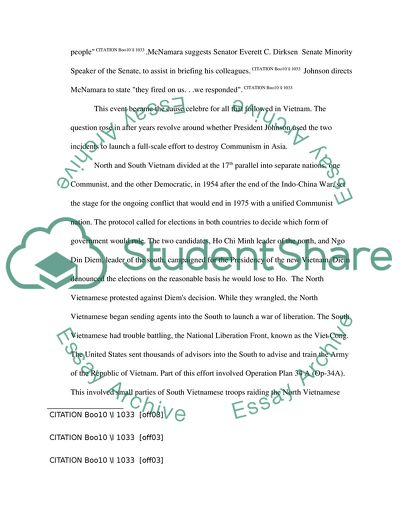Cite this document
(The Gulf of Tonkin Incident Assignment Example | Topics and Well Written Essays - 1500 words, n.d.)
The Gulf of Tonkin Incident Assignment Example | Topics and Well Written Essays - 1500 words. https://studentshare.org/history/1747100-the-gulf-of-tonkin-incident-of-august-2-and-4-1964-was-an-important-watershed-event-in-the-deepening-american-involvement-in-vietnam-the-johnson-administration-capitalized-on-these-incidents-to-vastly-expand-american-involvement-in-vietnam
The Gulf of Tonkin Incident Assignment Example | Topics and Well Written Essays - 1500 words. https://studentshare.org/history/1747100-the-gulf-of-tonkin-incident-of-august-2-and-4-1964-was-an-important-watershed-event-in-the-deepening-american-involvement-in-vietnam-the-johnson-administration-capitalized-on-these-incidents-to-vastly-expand-american-involvement-in-vietnam
(The Gulf of Tonkin Incident Assignment Example | Topics and Well Written Essays - 1500 Words)
The Gulf of Tonkin Incident Assignment Example | Topics and Well Written Essays - 1500 Words. https://studentshare.org/history/1747100-the-gulf-of-tonkin-incident-of-august-2-and-4-1964-was-an-important-watershed-event-in-the-deepening-american-involvement-in-vietnam-the-johnson-administration-capitalized-on-these-incidents-to-vastly-expand-american-involvement-in-vietnam.
The Gulf of Tonkin Incident Assignment Example | Topics and Well Written Essays - 1500 Words. https://studentshare.org/history/1747100-the-gulf-of-tonkin-incident-of-august-2-and-4-1964-was-an-important-watershed-event-in-the-deepening-american-involvement-in-vietnam-the-johnson-administration-capitalized-on-these-incidents-to-vastly-expand-american-involvement-in-vietnam.
“The Gulf of Tonkin Incident Assignment Example | Topics and Well Written Essays - 1500 Words”. https://studentshare.org/history/1747100-the-gulf-of-tonkin-incident-of-august-2-and-4-1964-was-an-important-watershed-event-in-the-deepening-american-involvement-in-vietnam-the-johnson-administration-capitalized-on-these-incidents-to-vastly-expand-american-involvement-in-vietnam.


